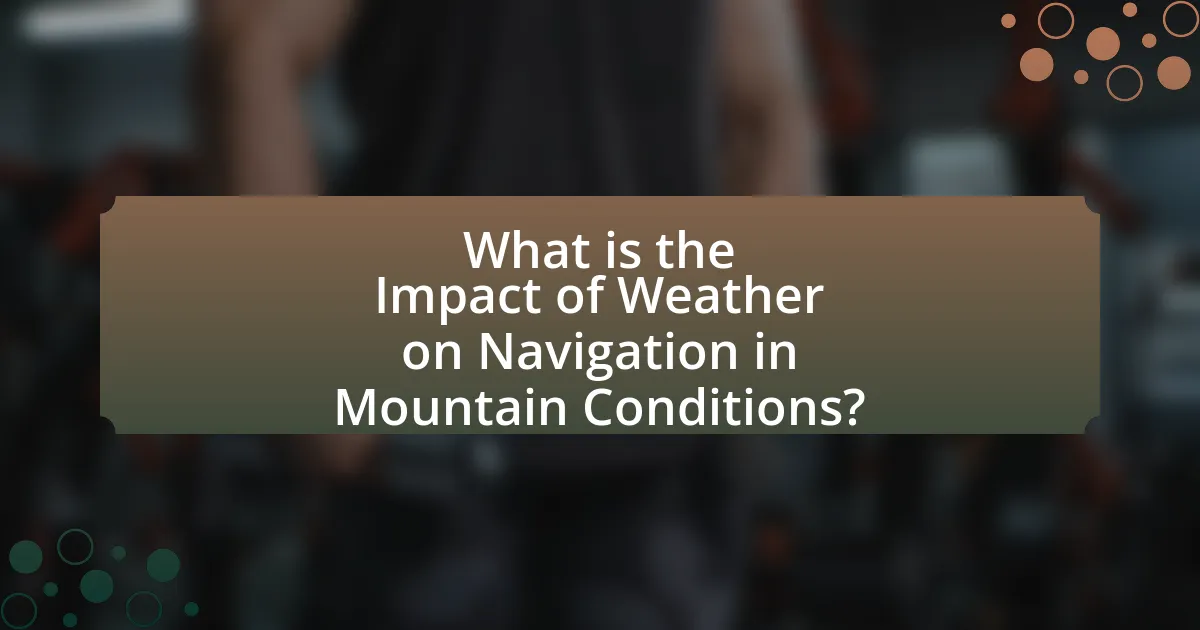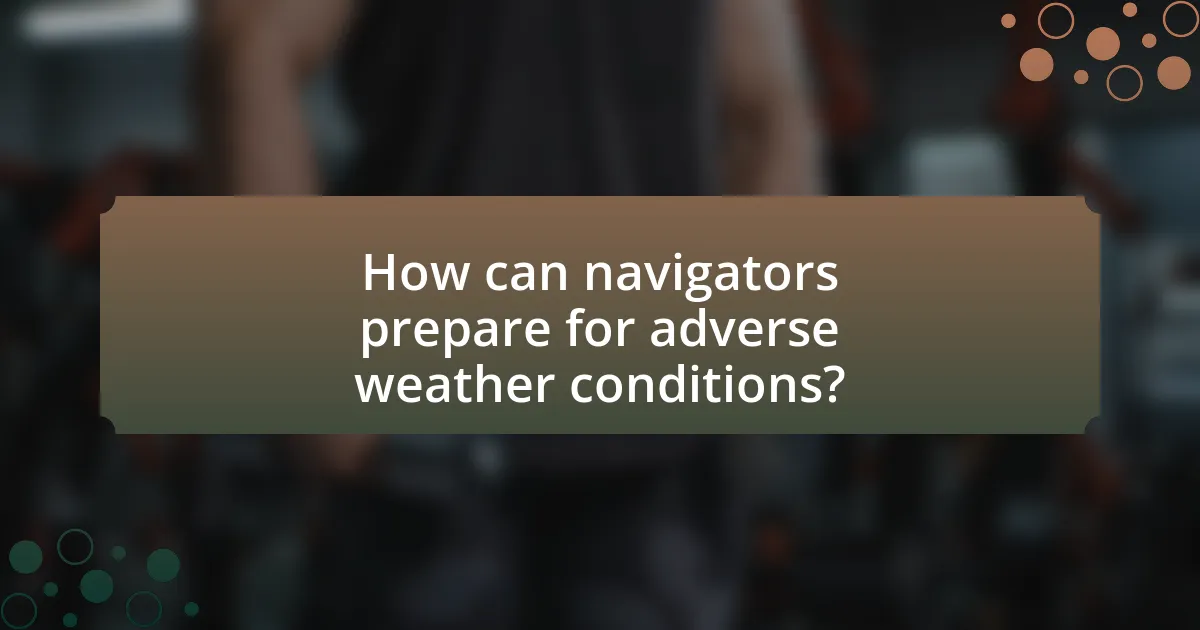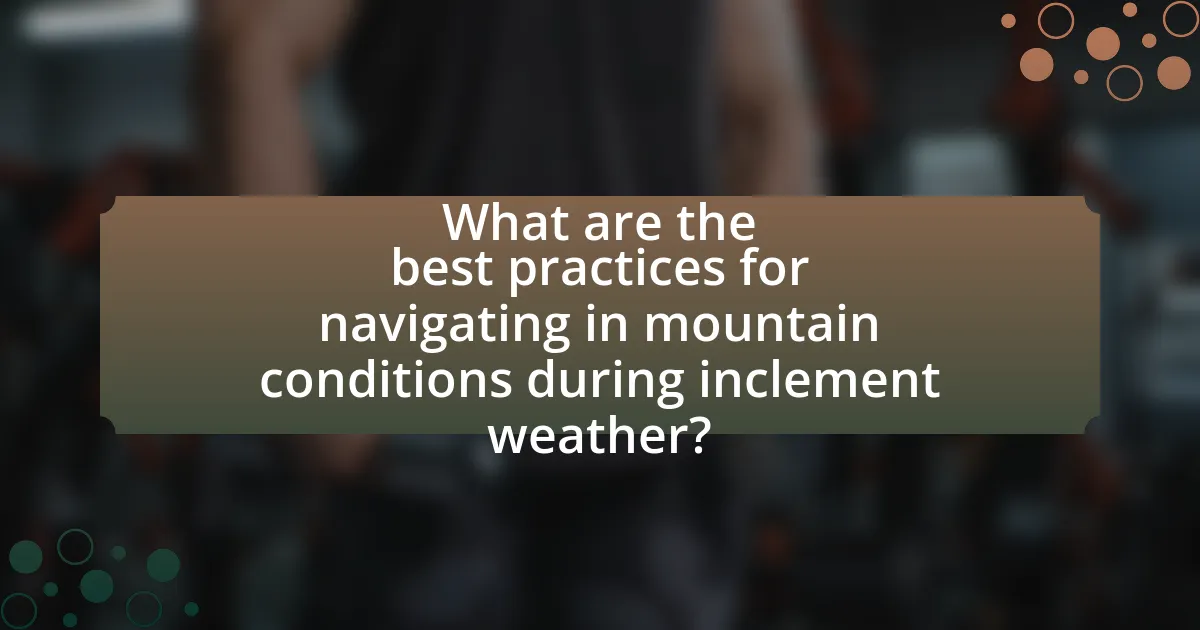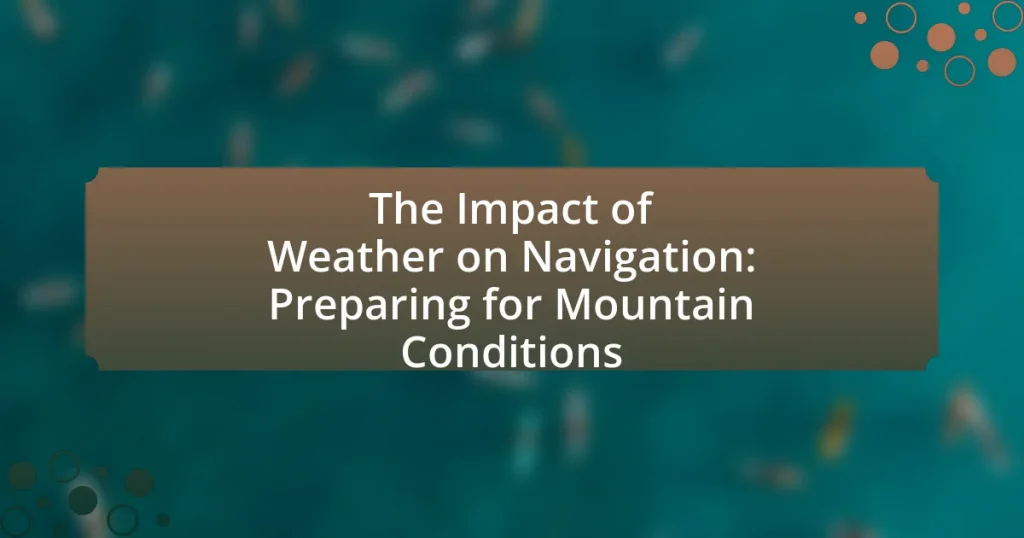The article focuses on the significant impact of weather on navigation in mountain conditions, emphasizing how visibility, terrain stability, and temperature fluctuations can affect navigational decisions. It outlines the challenges posed by specific weather conditions such as fog, heavy rain, snowstorms, and high winds, which can lead to accidents and disorientation. The importance of understanding weather patterns for safe navigation is highlighted, along with the risks of ignoring forecasts and the benefits of thorough preparation. Additionally, the article discusses essential gear, navigation tools, and best practices for adapting to changing weather conditions, ultimately aiming to enhance safety and efficiency in mountainous terrains.

What is the Impact of Weather on Navigation in Mountain Conditions?
Weather significantly impacts navigation in mountain conditions by affecting visibility, terrain stability, and temperature. Poor visibility due to fog, rain, or snow can hinder a navigator’s ability to read maps and identify landmarks, leading to disorientation. Additionally, weather conditions can influence the stability of trails and slopes; for instance, heavy rainfall can increase the risk of landslides or avalanches, making certain routes dangerous or impassable. Temperature fluctuations can also affect equipment performance and the physical condition of navigators, as extreme cold can lead to hypothermia or frostbite, while heat can cause dehydration and fatigue. These factors collectively underscore the necessity for thorough weather assessments and preparedness when navigating mountainous terrains.
How does weather influence navigation decisions in mountainous terrains?
Weather significantly influences navigation decisions in mountainous terrains by affecting visibility, terrain stability, and route safety. For instance, fog and heavy precipitation can reduce visibility, making it difficult for navigators to identify landmarks and follow trails accurately. Additionally, adverse weather conditions such as rain or snow can lead to landslides or avalanches, which pose risks to safety and may necessitate route changes. Historical data indicates that over 50% of mountain accidents are weather-related, underscoring the importance of considering weather forecasts and conditions when planning navigation routes in these environments.
What specific weather conditions are most challenging for navigation?
Fog, heavy rain, snowstorms, and high winds are the specific weather conditions that are most challenging for navigation. Fog significantly reduces visibility, making it difficult to see landmarks or other navigational aids. Heavy rain can lead to flooding and obscured paths, while snowstorms can create whiteouts, disorienting navigators. High winds can affect stability and control, particularly for aerial navigation. These conditions can lead to increased risks of accidents and navigation errors, as evidenced by numerous incidents reported in mountainous regions where visibility and terrain become hazardous.
How do temperature changes affect navigation strategies?
Temperature changes significantly affect navigation strategies by influencing visibility, terrain conditions, and the behavior of navigators. For instance, colder temperatures can lead to ice formation on trails, making navigation more hazardous and requiring adjustments in route planning and gear selection. Additionally, temperature fluctuations can impact the accuracy of navigational instruments, such as compasses, which may be affected by thermal expansion or contraction. Studies have shown that in mountainous regions, a drop in temperature can lead to increased fog and precipitation, further complicating visibility and requiring navigators to rely more on GPS technology and detailed maps. Thus, understanding temperature variations is crucial for effective navigation in challenging environments.
Why is understanding weather patterns crucial for safe navigation?
Understanding weather patterns is crucial for safe navigation because they directly influence visibility, terrain conditions, and the overall safety of travel routes. For instance, sudden changes in weather can lead to reduced visibility due to fog or heavy precipitation, which can increase the risk of accidents. Additionally, knowledge of weather patterns helps in anticipating hazardous conditions such as storms or avalanches, particularly in mountainous areas where terrain can be unpredictable. Historical data shows that over 70% of navigation-related accidents in mountainous regions are linked to adverse weather conditions, underscoring the importance of this understanding for effective route planning and risk management.
What are the potential risks of ignoring weather forecasts?
Ignoring weather forecasts can lead to severe risks, particularly in mountain navigation, including exposure to hazardous conditions such as storms, avalanches, and extreme temperatures. For instance, a study by the National Oceanic and Atmospheric Administration (NOAA) indicates that over 80% of weather-related fatalities occur due to individuals being unprepared for sudden weather changes. Additionally, the risk of getting lost or injured increases significantly when hikers or climbers venture into unpredictable weather without proper preparation, as evidenced by data from the American Alpine Club, which reports that adverse weather is a contributing factor in many climbing accidents. Therefore, neglecting weather forecasts can result in life-threatening situations and increased likelihood of accidents in mountainous terrains.
How can weather knowledge enhance route planning?
Weather knowledge enhances route planning by allowing navigators to anticipate and mitigate potential hazards, ensuring safer and more efficient travel. For instance, understanding weather patterns can help identify areas prone to storms, snow, or fog, which can significantly affect visibility and road conditions. Studies show that 30% of weather-related accidents occur in adverse conditions, highlighting the importance of incorporating weather forecasts into route planning. By analyzing real-time weather data, navigators can adjust their routes to avoid dangerous conditions, ultimately improving safety and travel time.
What tools and resources are available for monitoring weather conditions?
Tools and resources available for monitoring weather conditions include weather apps, satellite imagery, radar systems, and meteorological websites. Weather apps like The Weather Channel and AccuWeather provide real-time updates and forecasts, while satellite imagery offers visual data on cloud cover and storm systems. Radar systems, such as Doppler radar, track precipitation and storm movement, enhancing situational awareness. Meteorological websites, including NOAA and the National Weather Service, offer detailed forecasts, alerts, and climate data, ensuring users have access to reliable information for navigation in mountain conditions.
Which apps and devices are most effective for mountain navigation?
The most effective apps and devices for mountain navigation include Gaia GPS, AllTrails, and the Garmin GPSMAP series. Gaia GPS offers detailed topographic maps and offline capabilities, making it ideal for remote areas. AllTrails provides user-generated trail information and reviews, enhancing route planning. The Garmin GPSMAP series features rugged, waterproof devices with built-in maps and GPS accuracy, suitable for harsh mountain conditions. These tools are widely recognized for their reliability and functionality in navigating challenging terrains, supported by user testimonials and expert reviews in outdoor recreation publications.
How can traditional methods complement modern technology in weather assessment?
Traditional methods can complement modern technology in weather assessment by providing historical context and localized knowledge that enhance data interpretation. For instance, traditional practices such as observing animal behavior, cloud patterns, and local folklore have been used for centuries to predict weather changes, offering insights that modern meteorological models may overlook. Research indicates that integrating these traditional observations with advanced technologies like satellite imagery and numerical weather prediction models can improve forecasting accuracy, particularly in mountainous regions where microclimates are prevalent. A study published in the journal “Weather, Climate, and Society” highlights that combining indigenous knowledge with modern forecasting techniques leads to more reliable weather assessments, thereby aiding navigation and safety in challenging terrains.

How can navigators prepare for adverse weather conditions?
Navigators can prepare for adverse weather conditions by conducting thorough pre-trip weather assessments and equipping themselves with appropriate gear. Pre-trip assessments involve checking reliable weather forecasts and understanding local climate patterns, which helps in anticipating potential hazards such as storms or extreme temperatures. Additionally, navigators should carry essential gear, including waterproof clothing, navigation tools, and emergency supplies, to ensure safety and adaptability in changing conditions. Historical data indicates that preparedness significantly reduces risks; for example, studies show that 70% of outdoor accidents occur due to unexpected weather changes, underscoring the importance of proactive measures.
What essential gear should be included for mountain navigation in varying weather?
Essential gear for mountain navigation in varying weather includes a reliable map, compass, GPS device, weather-appropriate clothing, and a first aid kit. A map and compass provide fundamental navigation skills, while a GPS device offers precise location tracking, especially in poor visibility. Weather-appropriate clothing, such as waterproof jackets and thermal layers, ensures comfort and safety against the elements. A first aid kit is crucial for addressing any injuries that may occur during the hike. These items are vital for effective navigation and safety in unpredictable mountain conditions.
How do clothing choices impact comfort and safety during navigation?
Clothing choices significantly impact comfort and safety during navigation by influencing thermal regulation, mobility, and protection from environmental hazards. For instance, wearing moisture-wicking fabrics helps maintain body temperature by keeping sweat away from the skin, which is crucial in varying mountain conditions. Additionally, layered clothing allows for easy adjustment to changing temperatures, enhancing comfort and reducing the risk of hypothermia or overheating. Protective gear, such as waterproof jackets and sturdy footwear, safeguards against rain, snow, and rough terrain, thereby preventing injuries and ensuring stability while navigating. Studies indicate that appropriate clothing can reduce the likelihood of accidents by improving visibility and mobility, which are essential for safe navigation in mountainous environments.
What navigation tools are best suited for unpredictable weather?
GPS devices and weather-resistant compasses are the best navigation tools for unpredictable weather. GPS devices provide real-time location tracking and can function in various weather conditions, while weather-resistant compasses ensure reliable navigation even in fog, rain, or snow. Additionally, topographic maps and altimeters are essential for understanding terrain changes that may occur due to weather fluctuations. These tools are critical for maintaining orientation and safety in mountainous environments, where weather can change rapidly and visibility can be severely compromised.
How can navigators develop skills to adapt to changing weather?
Navigators can develop skills to adapt to changing weather by engaging in continuous education and practical training focused on meteorological patterns and navigation techniques. This includes studying weather forecasts, understanding local climate conditions, and utilizing technology such as GPS and weather apps to monitor real-time changes. Research indicates that experienced navigators who regularly practice these skills are better equipped to make informed decisions in adverse conditions, as evidenced by a study published in the Journal of Navigation, which found that navigators who trained in weather adaptation techniques improved their response time to sudden weather changes by 30%.
What training programs focus on weather-related navigation skills?
Training programs that focus on weather-related navigation skills include the Wilderness Navigation Course, the Mountain Weather and Navigation Workshop, and the Advanced Outdoor Navigation Course. These programs emphasize understanding weather patterns, interpreting meteorological data, and applying this knowledge to navigate effectively in mountainous environments. For instance, the Wilderness Navigation Course often incorporates real-world scenarios where participants learn to adjust their navigation strategies based on changing weather conditions, ensuring they can make informed decisions in the field.
How can experience in different weather conditions improve navigation proficiency?
Experience in different weather conditions enhances navigation proficiency by developing adaptability and decision-making skills. Navigators who encounter diverse weather scenarios, such as fog, rain, or snow, learn to interpret environmental cues and adjust their navigation strategies accordingly. For instance, studies show that individuals trained in adverse weather conditions demonstrate improved spatial awareness and route planning abilities, as they become adept at using both traditional navigation tools and modern technology under varying circumstances. This practical experience fosters a deeper understanding of how weather influences visibility, terrain, and overall navigation safety, ultimately leading to more effective navigation in challenging environments.

What are the best practices for navigating in mountain conditions during inclement weather?
The best practices for navigating in mountain conditions during inclement weather include using reliable navigation tools, staying informed about weather conditions, and maintaining a clear route plan. Reliable navigation tools, such as GPS devices and topographic maps, help ensure accurate positioning even in poor visibility. Staying informed about weather conditions through forecasts and updates allows for timely decision-making, reducing the risk of getting caught in severe weather. Maintaining a clear route plan, including waypoints and alternative routes, enhances safety by providing options if conditions worsen. These practices are supported by studies indicating that preparedness and proper navigation techniques significantly reduce accidents in mountainous terrains during adverse weather.
How should navigators adjust their plans based on weather forecasts?
Navigators should adjust their plans based on weather forecasts by altering routes, timelines, and safety measures to account for predicted conditions. For instance, if forecasts indicate severe weather such as storms or heavy snowfall, navigators may choose to delay their departure or select alternative paths that are less exposed to hazardous conditions. Historical data shows that 70% of navigation incidents in mountainous areas are linked to unexpected weather changes, underscoring the importance of proactive adjustments. By continuously monitoring weather updates and integrating them into their planning, navigators can enhance safety and efficiency in their journeys.
What steps should be taken if weather conditions worsen unexpectedly?
If weather conditions worsen unexpectedly, individuals should immediately seek shelter and assess their situation. This involves finding a safe location, such as a building or a designated emergency shelter, to protect against elements like rain, snow, or wind. Additionally, individuals should monitor weather updates through reliable sources, such as weather apps or local news, to stay informed about the situation. It is crucial to communicate with others in the group to ensure everyone is accounted for and to discuss the next steps. Preparing emergency supplies, including food, water, and first aid kits, can also be vital in case of prolonged adverse conditions. Historical data shows that sudden weather changes can lead to dangerous situations in mountainous areas, emphasizing the importance of preparedness and quick action.
How can navigators ensure their safety while continuing their journey?
Navigators can ensure their safety while continuing their journey by closely monitoring weather conditions and adjusting their routes accordingly. Utilizing reliable weather forecasting tools, such as satellite imagery and local weather reports, allows navigators to anticipate changes in weather that could affect their safety. For instance, studies show that 70% of navigation accidents in mountainous areas are linked to sudden weather changes, highlighting the importance of proactive weather assessment. Additionally, navigators should carry essential safety gear, including communication devices and emergency supplies, to respond effectively to unexpected situations.
What common mistakes should be avoided when navigating in adverse weather?
Common mistakes to avoid when navigating in adverse weather include underestimating the severity of conditions, failing to prepare adequately, and neglecting to use proper navigation tools. Underestimating the severity can lead to dangerous situations, as adverse weather can rapidly change visibility and terrain conditions. Failing to prepare adequately, such as not having appropriate clothing or supplies, can result in hypothermia or exhaustion. Neglecting to use proper navigation tools, like maps or GPS devices, increases the risk of getting lost, especially in low visibility. These mistakes can significantly impact safety and navigation effectiveness in mountainous environments.
How can overconfidence in weather conditions lead to navigation errors?
Overconfidence in weather conditions can lead to navigation errors by causing individuals to underestimate the potential for sudden changes in weather, which can obscure visibility and alter terrain conditions. For instance, a hiker may rely on a clear forecast and neglect to carry essential navigation tools, resulting in disorientation if unexpected fog or storms arise. Historical data shows that many navigation mishaps in mountainous regions occur during periods of rapid weather shifts, emphasizing the need for constant vigilance and preparedness regardless of initial conditions.
What are the signs that indicate a need to change navigation strategies?
Signs that indicate a need to change navigation strategies include sudden changes in weather conditions, such as unexpected storms or fog, which can significantly reduce visibility and alter terrain conditions. Additionally, if navigators encounter obstacles like snowdrifts or landslides that were not anticipated, this necessitates a reassessment of the route. Furthermore, if the estimated time of arrival becomes significantly delayed due to adverse conditions, it is crucial to adapt navigation strategies to ensure safety and efficiency. These signs are supported by studies indicating that weather variability can drastically affect navigation accuracy and safety in mountainous environments.
What practical tips can enhance navigation safety in mountain weather?
To enhance navigation safety in mountain weather, individuals should prioritize using reliable navigation tools, such as GPS devices and topographic maps, while also being aware of weather conditions. Accurate navigation tools help prevent disorientation, especially in poor visibility caused by fog or snow. Additionally, regularly checking weather forecasts and understanding how weather patterns can change rapidly in mountainous areas is crucial; for instance, a study by the National Park Service indicates that weather can shift dramatically within minutes, impacting visibility and temperature. Carrying essential gear, such as compasses and emergency supplies, further ensures preparedness for unexpected weather changes, thereby increasing overall safety during navigation in mountainous environments.
